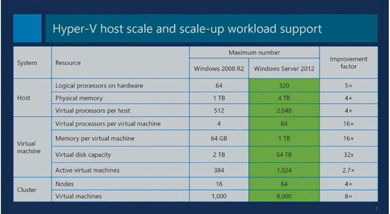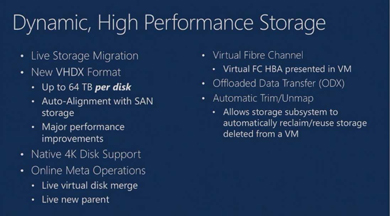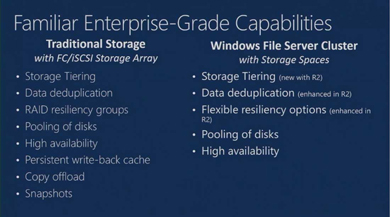News
Microsoft Details Windows Server 2012 R2 Storage, Networking Changes
- By Kurt Mackie
- June 19, 2013
Windows Server 2012 R2, which may arrive as a public preview release next week, will bring some networking, compute and storage improvements that build on what Microsoft initiated with Windows Server 2012.
The "customer preview" of Windows Server 2012 R2 is expected to appear close to Microsoft's Build developer event on June 26, although Microsoft has just said it will arrive this month. The final product release is expected by year's end, along with System Center 2012 R2. An updated Windows Intune is expected then, too.
Some of the R2 nuances were explained at a Microsoft TechEd session held earlier this month by Jeff Woolsey, program manager for Windows Server and cloud. His presentation included a review of improvements in Windows Server 2012 as well, but it mostly focused on the new R2 details. The R2 version mostly advances networking, compute and storage capabilities that Microsoft had initiated with Windows Server 2012. Many of the improvements are aimed at solving issues for cloud service providers in particular.
Windows Server 2012 already has some workload capacity advancements over Windows Server 2008 R2, as shown in this slide shown by Woolsey:
 [Click on image for larger view.]
Scale-up improvements in Windows Server 2012. (Source: Microsoft TechEd, June 3, 2013)
[Click on image for larger view.]
Scale-up improvements in Windows Server 2012. (Source: Microsoft TechEd, June 3, 2013)
He emphasized that Windows Azure runs the same Hyper-V and same Windows Server 2012 technology as Microsoft's customer premises-installed versions. He added a marketing pitch, claiming that Microsoft's workloads run best on Microsoft's Hyper-V hypervisor and that on a daily basis, within the Server and Tools Division, Microsoft tests more than 25,000 virtual machines (VMs) per day, at minimum, with an average of 500,000 VMs tested per month. Woolsey reemphasized current Microsoft's three clouds message, which offers organizations a choice to tap public, private or service provider clouds, or use a hybrid approach. He contrasted that approach with the competition.
"If you talk to VMware, they're going to tell you, 'You know what, cloud is that thing running in the bottom corner; it's that private thing.' Or they're working on some sort of hybridy thing that no one really understands yet," Woolsey said. "If you talk to Amazon, they'll tell you, 'No, no, cloud is actually running VMs up on Amazon -- that's that infrastructure-as-a-service thing.' If you talk to Salesforce.com, they'll tell you something different. They'll say, 'No, no, no, neither of those are cloud -- cloud is actually running on Salesforce.com SaaS.' We fundamentally disagree with all of that. Cloud is all of those things."
His broader point was that virtualization and the cloud are distinct things, and that Microsoft has been using its Windows Azure cloud knowledge to build its server products, such as Windows Server 2012 R2, using the same technologies.
Storage Improvements
Woolsey said that Windows Server 2012 and Windows Server 2012 R2 have improvements that leverage storage area network (SAN) capabilities. He cited an "offloaded data transfer" (ODX) feature as an example, which can transfer data between two storage systems without using the local computer's CPU or network resources. With offloaded data transfer, "we can perform massive operations at a fraction of the speed by taking advantage of your SAN," he explained.
Another storage improvement in Windows Server 2012 R2 is an "automatic TRIM and unmap" feature. Automatic TRIM and unmap can make additional capacity within a SAN more readily available. Woolsey explained that currently, when running a VM with 60 GB of storage, if you delete 20-GB file within the VM, the SAN doesn't know enough to reclaim the free space. With automatic TRIM and unmap, Hyper-V and the VM notifies the file system of the additional space, and the file system notifies the SAN that the 20 GB file was deleted, enabling the SAN to reclaim the space.
Other storage improvements were shown in the following slide presented by Woolsey:
 [Click on image for larger view.]
Dynamic storage improvements. (Source: Microsoft TechEd, June 3, 2013)
[Click on image for larger view.]
Dynamic storage improvements. (Source: Microsoft TechEd, June 3, 2013)
The Storage Spaces feature of Windows Server 2012 has been improved with the R2 release. Storage Spaces allows IT pros to pool physical disks and "create LUNs [logical disks], with three-way mirroring." With the R2 version, Microsoft has added the capability to do tiering in Storage Spaces. Woolsey described tiering as "a core new development in Windows Server 2012 R2." It allows IT pros to leverage different storage media.
"Storage Spaces has been enhanced with the capability to pool a combination of SSDs [solid-state disks] and traditional spinning disks into a single virtual disk," a Microsoft blog post explains. "Data is automatically moved between tiers based on usage patterns."
Woolsey listed some of the Storage Spaces improvements in this slide:
 [Click on image for larger view.]
Storage Spaces improvements. (Source: Microsoft TechEd, June 3, 2013)
[Click on image for larger view.]
Storage Spaces improvements. (Source: Microsoft TechEd, June 3, 2013)
Virtualization and Networking Improvements
Microsoft delivered its "shared nothing live migration" feature with Hyper-V in Windows Server 2012. Woolsey described shared nothing live migration as migrating VMs from server to server with nothing but a network connection, even while the VMs are running. Microsoft also enabled "concurrent live migration" in which Windows Server 2012 enables the migration of multiple VMs simultaneously.
Now, with Windows Server 2012 R2, there is a new "cross-version live migration" capability (for example, migrating VMs across Windows Server 2012 and Windows Server 2012 R2). It's also possible to live migrate Linux-based VMs, which can tap "dynamic memory." The dynamic memory capability adds memory to a VM on the fly as a workload increases. More details on Microsoft's management improvements for Linux and Unix VMs can be found here.
Microsoft also added two live migration options, including live migration with compression plus live migration with remote direct memory access (RDMA). Those options derive from Microsoft's Hyper-V improvements in Windows Server 2012 R2.
Microsoft has a "live VM export" feature (also known as "cloning"), which gives IT pros the ability to diagnose a failed application without having to take down the whole VM. A new "Remote Desktop over VMBus" feature enables copy and paste activities between VMs, because Remote Desktop Services is now built into the VM. Data duplication has been improved in Windows Server 2012 R2 so that it now works with running VMs.
Microsoft added online "VHDX resizing," in which the size of a virtual hard disk can be resized on the fly, without having to shut it down. Small-to-medium businesses can use Hyper-V Replica to set up disaster recovery capabilities. Hyper-V Replica also works to facilitate "guest clustering" by cloud service providers, who can use that capability to deliver a high-availability service to customers and do it using a shared VHDX. This ability to create a tertiary replica is termed "extended replica" by Microsoft. Service providers get redundancy from the Hyper-V Replica feature and they also create an offline copy for their customers.
"With guest clustering and shared VHDX, everyone is happy," Woolsey said. "You can share infrastructure without presenting real LUNs to tenants. That's why it's an important feature."
Another feature added is "automatic VM activation," which is a benefit for service providers and enterprises running the Windows Server 2012 R2 Datacenter edition. Automatic activation enables them to more quickly create and move VMs with fewer licensing hassles.
Microsoft added software-defined networking improvements as represented by a new "multitenant gateway" feature in Windows Server 2012 R2. It allows the merging of networks on the same fabric, even those with conflicting IP addresses, Woolsey explained. For example, it's possible to create a subnet that overlaps with another one. With the new software-defined networking improvements in Windows Server 2012 R2, the IP address of the conflicting subnet doesn't need to be reset.
"We built network virtualization into the platform," Woolsey said. "It's already there in Windows Server 2012, and we're making it better in 2012 R2."
He added that R2 is improved now with a network gateway that is being tapped by Microsoft's partners. Those partners include F5 Networks, Iron Networks, Huawei (for gateway devices), Arista (OMI-based top of rack switch), Cisco, NEC, 5nine, inMon (Hyper-V switch extensions), as well as chipset makers Broadcom, Intel, Mellanox, Emulex and Brocade.